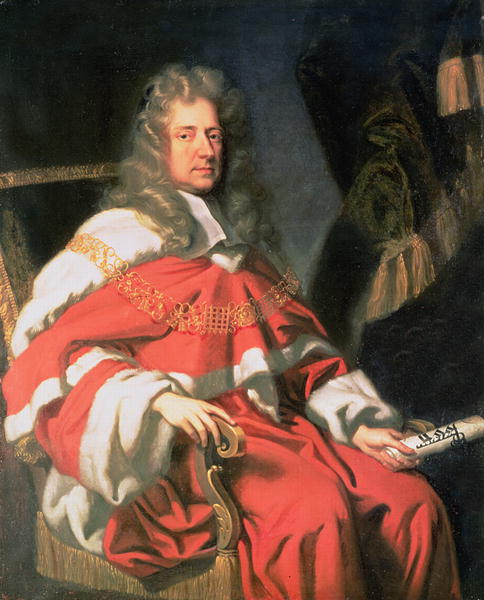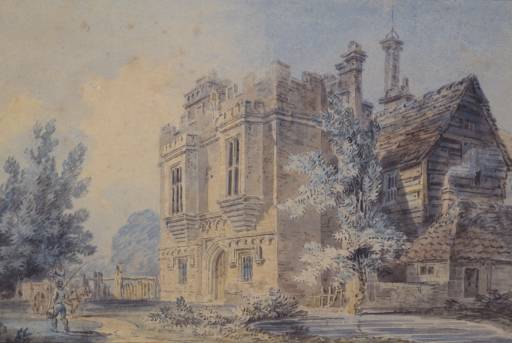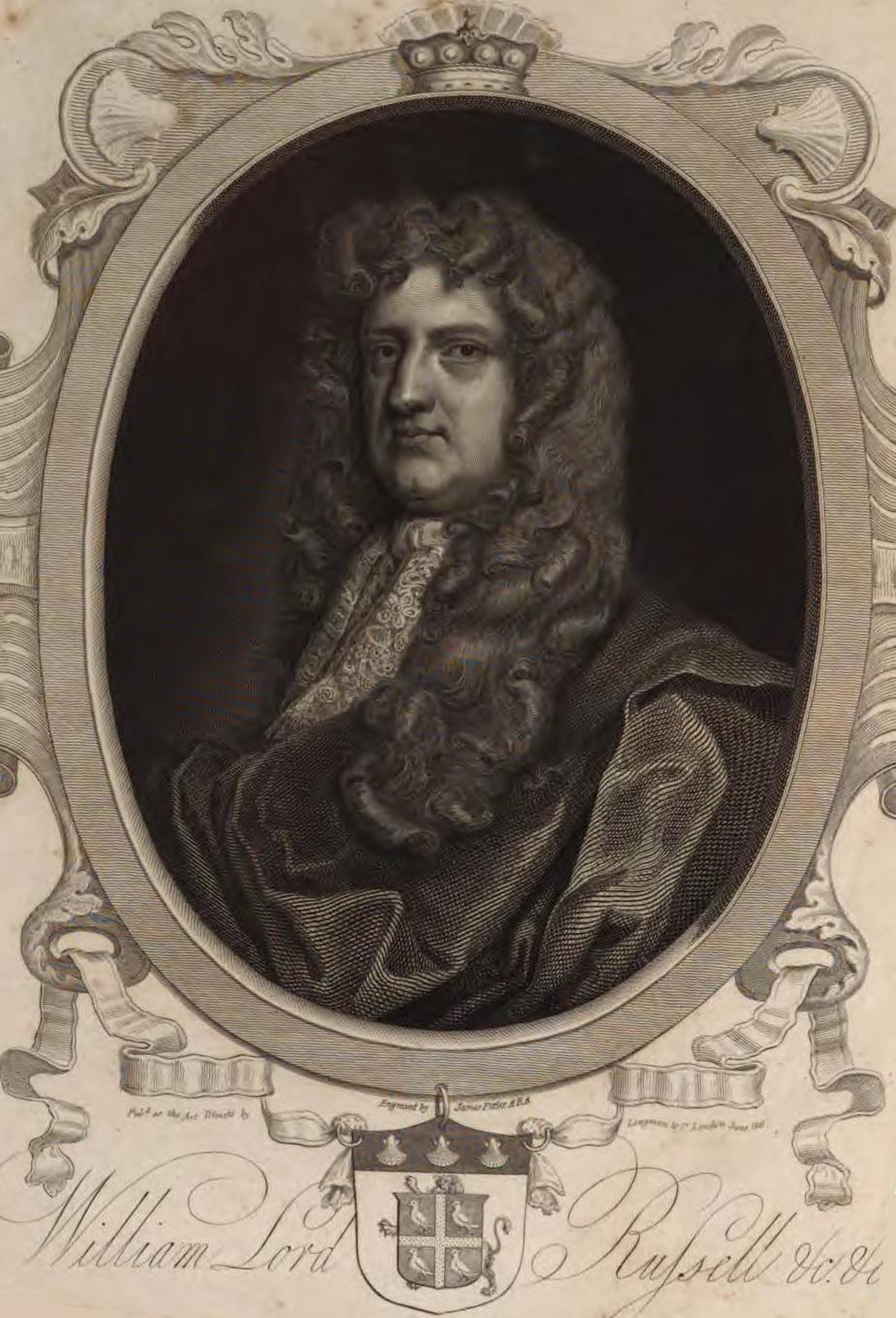|
Creswell Levinz
Sir Creswell Levinz (1627–1701), judge, was the second son of William Levinz, the elder, of Evenley, Northamptonshire, by Mary, second daughter of Richard Creswell of Purston in the same county. He was the brother of Baptist Levinz and William Levinz, and nephew of the Royalist Robert Levinz. Early career He took a sizarship in 1648 at Trinity College, Cambridge, but did not graduate, and in November 1655 entered Gray's Inn, where he was called to the bar in November 1661, was elected a bencher in 1678, and treasurer in 1679. He was knighted at Whitehall on 2 Oct. 1678, and made a King's Counsel about the same time. He represented the crown in the trials of Ireland, Pickering, Grove, Langhorn, Whitebread, and other supposed Popish Plotters in 1678–9. In October 1679 he was made Attorney-General. In December the celebrated proclamation against "tumultuous petitioning" was under discussion in the council, and Levinz was required to draft it. He refused at first, but eventuall ... [...More Info...] [...Related Items...] OR: [Wikipedia] [Google] [Baidu] |
Sir Creswell Levinz
Sir Creswell Levinz (1627–1701), judge, was the second son of William Levinz, the elder, of Evenley, Northamptonshire, by Mary, second daughter of Richard Creswell of Purston in the same county. He was the brother of Baptist Levinz and William Levinz, and nephew of the Royalist Robert Levinz. Early career He took a sizarship in 1648 at Trinity College, Cambridge, but did not graduate, and in November 1655 entered Gray's Inn, where he was called to the bar in November 1661, was elected a bencher in 1678, and treasurer in 1679. He was knighted at Whitehall on 2 Oct. 1678, and made a King's Counsel about the same time. He represented the crown in the trials of Ireland, Pickering, Grove, Langhorn, Whitebread, and other supposed Popish Plotters in 1678–9. In October 1679 he was made Attorney-General. In December the celebrated proclamation against "tumultuous petitioning" was under discussion in the council, and Levinz was required to draft it. He refused at first, but eventually co ... [...More Info...] [...Related Items...] OR: [Wikipedia] [Google] [Baidu] |
House Of Commons Of England
The House of Commons of England was the lower house of the Parliament of England (which incorporated Wales) from its development in the 14th century to the union of England and Scotland in 1707, when it was replaced by the House of Commons of Great Britain after the 1707 Act of Union was passed in both the English and Scottish parliaments at the time. In 1801, with the union of Great Britain and Republic of Ireland, Ireland, that house was in turn replaced by the House of Commons of the United Kingdom. Origins The Parliament of England developed from the Magnum Concilium that advised the English monarch in medieval times. This royal council, meeting for short periods, included ecclesiastics, noblemen, and representatives of the county, counties (known as "knights of the shire"). The chief duty of the council was to approve taxes proposed by the Crown. In many cases, however, the council demanded the redress of the people's grievances before proceeding to vote on taxation. Thus ... [...More Info...] [...Related Items...] OR: [Wikipedia] [Google] [Baidu] |
John Bernardi
Major John Bernardi (1657 – 20 September 1736) was an English soldier, adventurer and Jacobite conspirator. Bernardi is best known for his involvement in an assassination plot against William III, and his subsequent forty-year imprisonment, without proper trial, in Newgate prison. Early life Bernardi was born in Evesham into a wealthy family of Genoese origin. His grandfather, Philip, and father, Francis, had both served as Resident of the Republic of Genoa, though after a disagreement the latter had retired permanently to Evesham.Chambers, ''Biographical Illustrations of Worcestershire'', 1820, p.303 John Bernardi's "restless" temperament, along with what he claimed was "harsh" treatment by his father, led him to run away from home at the age of 13. He later wrote that on going through the gate he "kneeled down protesting and praying that he might never return, whilst his father lived".Bernardi, ''A Short History of the Life of Major John Bernardi, By Himself'', 1729, p. 5 ... [...More Info...] [...Related Items...] OR: [Wikipedia] [Google] [Baidu] |
Bloody Assizes
The Bloody Assizes were a series of trials started at Winchester on 25 August 1685 in the aftermath of the Battle of Sedgemoor, which ended the Monmouth Rebellion in England. History There were five judges: Sir William Montague (Lord Chief Baron of the Exchequer), Sir Robert Wright, Sir Francis Wythens (Justice of the King's Bench), Sir Creswell Levinz (Justice of the Common Pleas) and Sir Henry Pollexfen, led by Lord Chief Justice George Jeffreys. Over 1,000 rebels were in prison awaiting the trials, which started in the Great Hall of Winchester Castle in Winchester on 26 August. The first notable trial was that of an elderly gentlewoman named Dame Alice Lisle. The jury reluctantly found her guilty and, the law recognising no distinction between principals and accessories in treason, she was sentenced to be burned. This was commuted to beheading, with the sentence being carried out in Winchester market-place on 2 September 1685. From Winchester the court proceeded throug ... [...More Info...] [...Related Items...] OR: [Wikipedia] [Google] [Baidu] |
George Jeffreys, 1st Baron Jeffreys
George Jeffreys, 1st Baron Jeffreys, PC (15 May 1645 – 18 April 1689), also known as "the Hanging Judge", was a Welsh judge. He became notable during the reign of King James II, rising to the position of Lord Chancellor (and serving as Lord High Steward in certain instances). His conduct as a judge was to enforce royal policy, resulting in a historical reputation for severity and bias. Early years and education Jeffreys was born at the family estate of Acton Hall, in Wrexham, in North Wales, the sixth son of John and Margaret Jeffreys. His grandfather, John Jeffreys (died 1622), had been Chief Justice of the Anglesey circuit of the Great Sessions. His father, also John Jeffreys (1608–1691), was a Royalist during the English Civil War, but was reconciled to the Commonwealth and served as High Sheriff of Denbighshire in 1655. His brothers were people of note. Thomas, later Sir Thomas (knighted in 1686), was the English Consul in Spain and a Knight of Alcántara. Wil ... [...More Info...] [...Related Items...] OR: [Wikipedia] [Google] [Baidu] |
William Cobbett
William Cobbett (9 March 1763 – 18 June 1835) was an English pamphleteer, journalist, politician, and farmer born in Farnham, Surrey. He was one of an agrarian faction seeking to reform Parliament, abolish "rotten boroughs", restrain foreign activity, and raise wages, with the goal of easing poverty among farm labourers and small land holders. Cobbett backed lower taxes, saving, reversing commons enclosures and resisting the 1821 gold standard. He opposed borough-mongers, sinecurists, bureaucratic "tax-eaters" and stockbrokers. His radicalism furthered the Reform Act 1832 and gained him one of two newly created seats in Parliament for the borough of Oldham. His polemics range from political reform to religion, including Catholic emancipation. His best known book is ''Rural Rides'' (1830, in print). He argued against Malthusianism, saying economic betterment could support global population growth. Early life (1763–1791) William Cobbett was born in Farnham, Surrey, on 9 Mar ... [...More Info...] [...Related Items...] OR: [Wikipedia] [Google] [Baidu] |
Freehold Estate
In English law, a fee simple or fee simple absolute is an estate in land, a form of freehold ownership. A "fee" is a vested, inheritable, present possessory interest in land. A "fee simple" is real property held without limit of time (i.e., permanently) under common law, whereas the highest possible form of ownership is a "fee simple absolute," which is without limitations on the land's use (such as qualifiers or conditions that disallow certain uses of the land or subject the vested interest to termination). The rights of the fee-simple owner are limited by government powers of taxation, compulsory purchase, police power, and escheat, and may also be limited further by certain encumbrances or conditions in the deed, such as, for example, a condition that required the land to be used as a public park, with a reversion interest in the grantor if the condition fails; this is a fee simple conditional. History The word "fee" is related to the term fief, meaning a feudal lan ... [...More Info...] [...Related Items...] OR: [Wikipedia] [Google] [Baidu] |
Rye House Plot
The Rye House Plot of 1683 was a plan to assassinate King Charles II of England and his brother (and heir to the throne) James, Duke of York. The royal party went from Westminster to Newmarket to see horse races and were expected to make the return journey on 1 April 1683, but because there was a major fire in Newmarket on 22 March (which destroyed half the town), the races were cancelled, and the King and the Duke returned to London early. As a result, the planned attack never took place. Historians vary in their assessment of the degree to which details of the conspiracy were finalised. Whatever the state of the assassination plot, plans to mount a rebellion against the Stuart monarchy were being entertained by some opposition leaders in England. The government cracked down hard on those in a series of state trials, accompanied with repressive measures and widespread searches for arms. The Plot presaged, and may have hastened, the rebellions of 1685, the Monmouth Rebell ... [...More Info...] [...Related Items...] OR: [Wikipedia] [Google] [Baidu] |
William Russell, Lord Russell
William Russell, Lord Russell (29 September 163921 July 1683) was an English politician. He was a leading member of the Country Party, forerunners of the Whigs, who during the reign of King Charles II, laid the groundwork for opposition in the House of Commons to the accession of an openly Catholic king in Charles's brother James. This ultimately resulted in Russell's execution for treason, almost two years before Charles died and James acceded to the throne. Early life and marriage Born Hon. William Russell, he was the third son of William Russell, 5th Earl of Bedford, later created Duke of Bedford, and Lady Anne Carr. After the death of his elder brother Francis (1638–1679), he gained the courtesy title of Baron Russell and was thus referred to as Lord Russell. He and Francis were at Cambridge University in 1654. They then travelled abroad, visiting Lyon and Geneva, residing for a time at Augsburg. Russell's account makes for a colourful depiction of his travels. The tw ... [...More Info...] [...Related Items...] OR: [Wikipedia] [Google] [Baidu] |
Old Bailey
The Central Criminal Court of England and Wales, commonly referred to as the Old Bailey after the street on which it stands, is a criminal court building in central London, one of several that house the Crown Court of England and Wales. The street outside follows the route of the ancient wall around the City of London, which was part of the fortification's '' bailey'', hence the metonymic name. The Old Bailey has been housed in a succession of court buildings on the street since the sixteenth century, when it was attached to the medieval Newgate gaol. The current main building block was completed in 1902, designed by Edward William Mountford; its architecture is recognised and protected as a Grade II* listed building. An extension South Block was constructed in 1972, over the former site of Newgate gaol which was demolished in 1904. The Crown Court sitting in the Old Bailey hears major criminal cases from within Greater London. In exceptional cases, trials may be referred t ... [...More Info...] [...Related Items...] OR: [Wikipedia] [Google] [Baidu] |
Stephen College
Stephen College (also Colledge) (c.1635–1681) was an English joiner, activist Protestant, and supporter of the perjury underlying the fabricated Popish Plot. He was tried and executed for high treason, on somewhat dubious evidence, in 1681. Life He was born about 1635, and worked in the trade of carpentry, hence his nickname "the Protestant joiner". College was a skilled joiner: evidence of his work still survives to this day, in the form of the wooden panelling that he made for the Stationers Hall in 1674. He became known as an anti-Catholic political speaker. He had been a Presbyterian until the Restoration of 1660 when he conformed to the Church of England. He made himself notorious by his declamations against the papists, by writing and singing political ballads, and by inventing a weapon for self-defence at close quarters, which he called 'the Protestant flail'. He knew many persons of rank. Lord William Russell and Lady Berkeley showed him kindness, which inspired him wi ... [...More Info...] [...Related Items...] OR: [Wikipedia] [Google] [Baidu] |






_(cropped).jpg)
